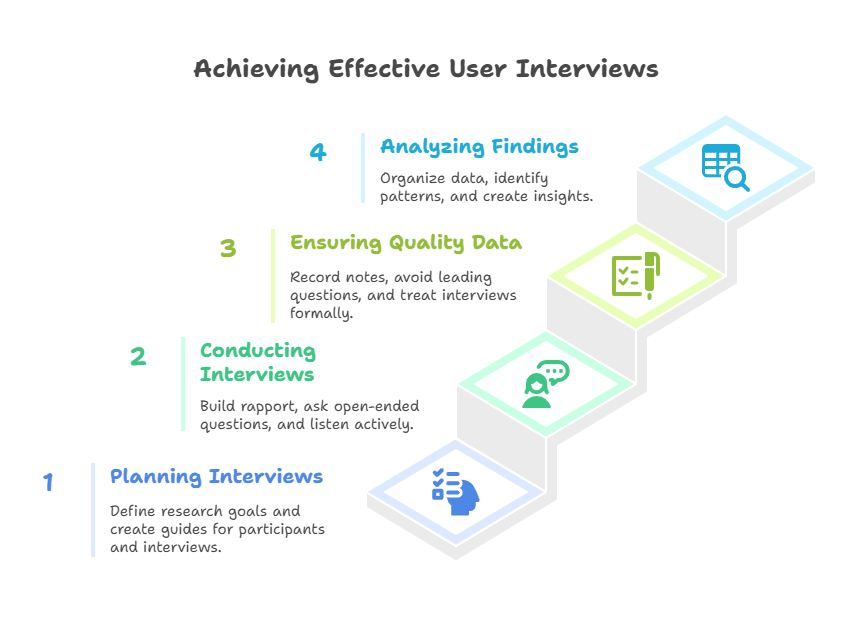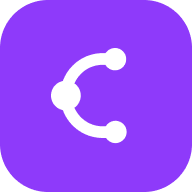How to Conduct User Interviews Effectively: A Practical Guide
Learn how to plan, conduct, and analyze user interviews to gain deep insights about your users' needs, experiences, and motivations.
What Are User Interviews and Why They Matter
User interviews are a research method where you ask participants questions about a topic, listen to their responses, and follow up to learn more. Unlike casual conversations, they're structured sessions designed to uncover what users need, value, and desire.
These interviews help you understand your users' experiences, pain points, and motivations at a deeper level. When conducted effectively, they provide rich qualitative data that surveys and analytics alone cannot capture. The insights gained can inform product decisions, improve user experience, and validate assumptions about your target audience.

Planning Your User Interviews
Define Your Research Goals
Before scheduling any interviews, clearly articulate what you want to learn. Are you exploring user needs for a new feature? Understanding why people abandon a process? Or learning about their current workflows? Specific goals will shape your entire approach.
Create a Participant Screening Guide
Identify the right participants by creating screening criteria that match your research objectives. Consider factors like demographics, experience level, usage patterns, or specific behaviors. This ensures you're talking to people who can provide relevant insights.
Develop Your Interview Guide
An effective interview guide should contain a few well-designed, open-ended questions that encourage participants to share detailed experiences. Avoid yes/no questions that limit conversation. Your guide should flow naturally from broader topics to more specific ones.
Conducting Effective Interviews
Build Rapport and Set the Stage
Begin each session by explaining the purpose, duration, and how the data will be used. Emphasize that there are no right or wrong answers. This creates a comfortable environment where participants feel safe to share honest feedback.
Ask Open-Ended Questions
Start with open-ended questions to build rapport and gather in-depth information. Questions that begin with "what," "how," or "tell me about" encourage storytelling rather than simple answers. For example, "What was your experience like when you first tried to complete this task?"
Practice Active Listening
Focus on understanding rather than just waiting for your turn to speak. Allow for pauses and silence—these moments often lead to deeper insights. Follow up on interesting points with probing questions like "Can you tell me more about that?" or "What made you decide to do it that way?"
Best Practices for Quality Data
Record and Take Notes
Always record sessions (with permission) to capture every detail. While recording, take timestamped notes about key moments, quotes, and observations. This makes analysis much more efficient later.
Avoid Leading Questions
Be careful not to phrase questions in ways that suggest a particular answer. Instead of "Don't you think this feature would be helpful?" ask "How would this feature fit into your current workflow?"
Treat Interviews as Formal Research
Remember to treat user interviews like a research study, not an informal chat. Maintain consistency across sessions by asking the same core questions while allowing flexibility to explore unique insights from each participant.
Analyzing and Synthesizing Findings
Organize Your Data
Familiarize yourself with your data by listening to recordings and transcribing key sections. Create a system for tagging and categorizing insights based on themes that emerge across multiple interviews.
Identify Patterns and Themes
Look for recurring pain points, behaviors, needs, and motivations. Group similar insights together to identify broader patterns. This synthesis turns individual anecdotes into actionable findings that can drive decision-making.
Create Shareable Insights
Transform your analysis into formats that stakeholders can easily understand and use. This might include user personas, journey maps, or summary reports highlighting key findings and recommendations.
Tools to Streamline Your Research Process
Planning and analyzing user interviews can be complex, but visual tools can help organize your thoughts and findings. ClipMind offers AI-powered mind mapping that lets you structure your interview guides, track insights, and identify patterns across multiple sessions.
For product managers conducting frequent user research, consider using our AI Competitor Analyzer to complement your interview findings with market context, or our Project Planner to manage your research timeline and resources effectively.
Effective user interviews require careful planning, skilled execution, and systematic analysis. By following these practices, you'll gather the deep insights needed to build products that truly meet user needs.
 ClipMind
ClipMind